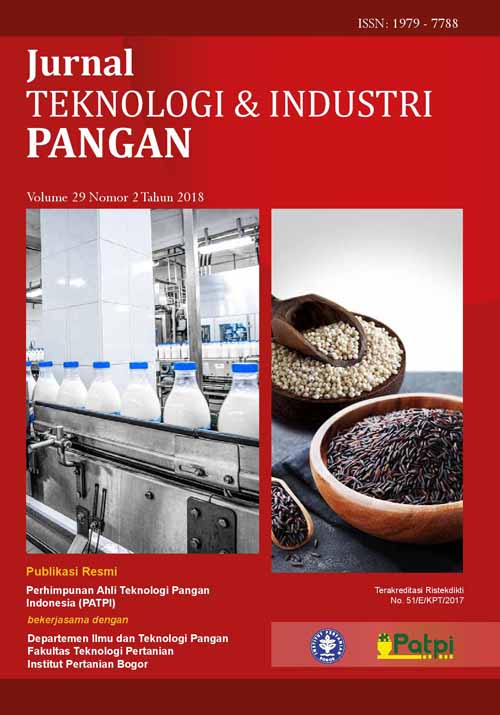FTIR-METABOLOMICS TO CORRELATE SORGHUM’S CHEMICAL PROFILE AND HCT-116 CYTOTOXICITY CHANGES DURING RICE-ANALOGUE PRODUCTION
Abstract
Rice-analogue (RA) made from sorghum (Sorghum bicolor L. Moench) has recently been popular in Indonesia for its potential as an alternative staple food besides rice. Sorghum has many phytochemicals with various functional properties including those which correlate to anticancer activity. The RA production in-volves several steps; polishing, milling, mixing, extruding, and oven drying. This study used FTIR based metabolomics to identify if these steps affect sorghum phytochemicals composition and its cytotoxicity acti-vity against HCT-116 cell lines in-vitro. It was discovered that sorghum cytotoxic activity was relatively sta-ble during the process. The RA final product (oven dried RA) showed higher activity (90.85%) as compared to other samples taken from previous step (2000 ppm dose). The correlation between FTIR profile and cytotoxic activity of RA was analyzed using one of the multivariate data analysis method namely orthogonal projection to the least square (OPLS). By comparing the OPLS data with FTIR data of compounds reported to be found in sorghum, it is shown that typical FTIR patterns for phenolic compounds particularly ferulic acids, p-coumaric acid, and procyanidins, as well as phytosterols, were highly correlated with RA’s cytotoxic activity. The signals were found to be dominant in the most active sample (oven dried RA). It can be concluded that sorghum phytochemicals responsible for its cytotoxic activity were not affected by processing steps, therefore RA is potential to be promoted as alternative func-tional staple food in Indonesia.
References
Budijanto S, Yuliyanti. 2012. Studi Persiapan Te-pung sorgum (Sorghum bicolor L. Moench) dan aplikasinya pada pembuatan beras analog. J Teknol Pertanian 13: 177-186.
Burdette A, Garner PL, Mayer EP, Hargrove JL, Hartle DK, Greenspan, P. 2010. Antiinflamma-tory activity of selected sorghum (Sorghum bicolor) brans. J Med Food 13: 879-887. DOI: 10.1089/jmf.2009.0147.
Dennis EG, Jeffery DW, Johnston MR, Perkins MV, Smith PA. 2012. Procyanidin oligomers. A new method for 4→8 interflavan bond formation using C8-boronic acids and iterative oligomer synthesis through a boron-protection strategy. Tetrahedron 68: 340-348. DOI: 10.1016/j.tet.20 11.10.039.
Gumu D, Korus J, Czechowska K, Bartoń H, Fołta M. 2010. The impact of extrusion on the content of polyphenols and antioxidant activity of rye grains (Secale cereale L.). Acta Sci Pol Technol Aliment 9: 319-330.
Holser RA. 2012. Principal component analysis of phenolic acid. Int Scholarly Res Notices Spec-troscopy 5: 1-5. DOI: 10.5402/2012/493203.
Hossain MA, Rahman SMM. 2015. Isolation and characterisation of flavonoids from the leaves of medicinal plant Orthosiphon stamineus. Arab J Chem 8: 218-221. DOI: 10.1016/j.arabjc.2011. 06.016.
Janicke B, Hegardtb C, Kroghc M. 2011. The anti-proliferative effect of dietary fiber phenolic com-pounds ferulic acid and p-coumaric acid on the cell cycle of Caco-2 cells. Nutr Cancer 63: 611-622. DOI: 10.1080/01635581.2011.538486.
Jemal A, Bray F, Melisa M, Ferlay J, Ward E, Forman D. 2011. Global cancer statistics. CA Cancer J Clin 61: 69-90. DOI 10.3322/caac.2 0107.
Juliani, Yuliana ND, Budijanto S, Wijaya CH, Khatib A. 2016. Senyawa inhibitor alfa-glukosidase dan antioksidan dari kumis kucing dengan pen-dekatan metabolomik berbasis FTIR. J Teknol Industri Pangan 27: 17-30. DOI: 10.6066/jtip. 2016.27.1.17.
Kuo PC, Liu HF, Chao JI. 2004. Survivin and P53 modulate quercetin-induced cell growth inhibi-tion and apoptosis in human lung carcinoma cells. J Biol Chem 279: 55875-55885. DOI: 10. 1047/jbc.M407985200.
Leguizamón C, Weller CL, Schlegel VL, Carr TP. 2009. Plant sterol and policosanol characteriza-tion of hexane extracts from grain sorghum, corn, and their DDGS. J Am Oil Chem Soc 86: 707-716. DOI: 10.1007/s11746-009-1398-z.
Menéndez-Carreño M, Steenbergen H, Janssen HG. 2012. Development and validation of a compre-hensive two-dimensional gas chromatography-mass spectrometry method for the analysis of phytosterol oxidation products in human plas-ma. Anal Bioanal Chem 402: 2023-2032. DOI: 10.1007/s00216-011-5432-2.
N'Dri D, Mazzeo T, Zaupa M, Ferracane R, Fogliano V, Pellegrini N. 2013. Effect of cooking on the total antioxidant capacity and phenolic profile of some whole-meal African cereals. J Sci Food Agric 93: 29-36. DOI: 10.1002/jsfa.5837.
Pop RM, Buzoianu AD, Raţi IV, Socaciu C. 2014. Untargeted metabolomics for sea buckthorn (Hippophae rhamnoides ssp. carpatica) berries and leaves: fourier transform infrared spectros-copy as a rapid approach for evaluation and discrimination. Not Bot Horti Agrobo 42: 545-550. DOI: 10.1583/nbha4229654.
Sadek NF, Yuliana ND, Prangdimurti E, Priyosoer yanto BP, Budijanto S. 2016. Potensi beras analog sebagai alternatif makanan pokok untuk mencegah penyakit degeneratif. J Pangan 25: 61-70.
Verpoorte R, Choi YH, Kim HK. 2005. Ethnopharma-cology and systems biology: A perfect holistic match. J Ethnopharmacol 100: 53-56. DOI: 10. 1016/j.jep.2005.05.033.
Wu Li, Huang Z, Qin P, Ren G. 2013. Effects on processing on phytochemical profiles and bio-logical activities for production of sorghum tea. Food Res Int 53: 678-685. DOI: 10.1016/j. foodres.2012.07.062.
Yang H, Yan F, Wu D, Huo M, Li J, Cao Y, Jiang Y. 2010. Recovery of phytosterols from waste resi-due of soybean oil deodorizer distillate. Biore-sour Technol 101: 1471-1476. DOI: 10.1016/j. biortech.2009.09.019.
Yuliana ND, Rosa D, Budijanto S, Verpoorte R, Choi YH. 2014. Identification of adenosine A1 recep-tor ligands from Morus alba L. stem bark by NMR metabolomics approach. Int Food Res J 21: 1067-1071.
Yusof NA, Isha A, Ismail IS, Khatib A, Shaari K, Abas F, Rukayadi Y. 2015. Infrared-metabolo-mics approach in detecting changes in andro-graphis paniculata metabolites due to different harvesting ages and times. J Sci Food Agr journal of the science of food and agriculture 95: 2533-2543. DOI: 10.1002/jsfa.6987.
Zbasnik R, Carr T, Weller C, Hwang KT, Wang L, Cuppett S, Schlegel V. 2009. Antiproliferation properties of grain sorghum dry distiller’s grain lipids in caco-2 cells. J Agric Food Chem 57: 10435-10441. DOI: 10.1021/jf902136p

